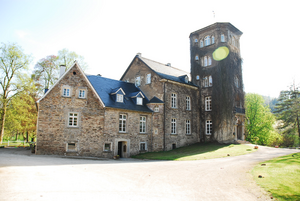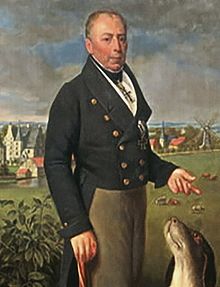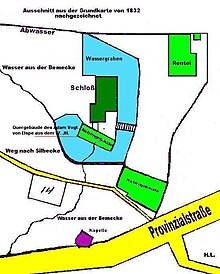House Bamenohl
| House Bamenohl | ||
|---|---|---|
|
Front view |
||
| Alternative name (s): | Bamenohl Castle | |
| Creation time : | First mentioned in 1324 | |
| Castle type : | Niederungsburg | |
| Conservation status: | receive | |
| Standing position : | Nobles | |
| Construction: | Quarry stone | |
| Place: | Bamenohl | |
| Geographical location | 51 ° 9 '43 " N , 7 ° 59' 14" E | |
| Height: | 242 m above sea level NHN | |
|
|
||
Haus Bamenohl is a castle in Bamenohl , Finnentrop municipality , Olpe district in North Rhine-Westphalia .
history
14th Century
The first owner of the Bamenohl family was probably the von Hundem family called Pepersack . The von Heygen family came into possession of Bamenohl through marriage . Bawenole inferiore is first mentioned in a document on March 5, 1324 : Herbord Vogt von Heyen leaves Count Wilhelm von Arnsberg his own Conradum (Konrad), the son of Dietrich von Adorpe, and receives in exchange the Gobelinus from Bawenole inferiore (Nieder-Bamenohl) . It does not necessarily have to be the present-day castle, but the cellar vaults and the walls, which are up to two meters thick, suggest that it was built in the 14th or 15th century. At this time there was also a chapel, which is first mentioned in a document from 1362.
In 1379 the huyss zu Babenole is mentioned again: At that time , Heidenreich van Heyen swore with his brothers to the Archbishop of Cologne Friedrich III. von Saar renounced feuds (so-called original feuds ) and declared house and the hoff zu Overenbabenole to be an open house . At that time, the Bamenohl family had patronage over the churches of St. Jakobus in Elspe and St. Hippolytus in Helden .
There was already a free chair in Bamenohl in the 14th century : In 1395 Ruprecht II , Count Palatine of the Rhine, acquired ownership rights to the castle and the free chair of Bamelen for an annual payment of 30 Rhenish guilders . In the same year, Wilhelm Vogt von Elspe , Heinrich von Dusendschuren and Heineman von Heyen sued the city of Frankfurt on the free seat in front of the fortress at Babenole between the two bridges because their mercenaries had destroyed two churches and churchyards.
15th to 17th centuries
In the further course of inheritance, the von Plettenberg family first came into (co-) ownership of Haus Bamenohl around 1433 . In 1471 the brothers Wilhelm and Johann Vogt von Elspe, Heidenreich von Plettenberg and Noldeke von Berninghausen jointly owned Sloße Babenelle . The gentlemen von Dünschede were also co-owners .
After the inheritance was divided in 1474 and sold, the von Plettenberg and Vogt von Elspe families each owned half a share of Bamenohl at the beginning of the 16th century. In the 16th century the property was divided into a lower and an upper house, based on the course of the Lenne , which flows here from south to north. Today's castle belonged to the lower house, the upper house was only a few meters southwest of it. In 1580, Bernhard Vogt von Elspe zu Borghausen inherited the other half of Bamenohl and moved his residence there.
In 1647 Adam Vogt von Elspe built an outbuilding, today's east wing, in GROSEM KRIG STRYT AND WIDERWERTIGLICH , as it says on a stone slab. This construction could only succeed at the end of the Thirty Years War because the family was in possession of several letters of protection, which spared the house from robbery and looting. In the same year the chapel, which was demolished in the 1930s, was built.
18th century
In 1755 Bamel belonged to the Waldenburg office and the Elspe parish. After the owner of the Upper House had changed several times (u. A. Of Steckenberg, of Calenberg ), acquired in 1781, the last governor of Elspe, Gisbert Moritz Konrad Vogt called Elspe Voss to Rodenberg , then owner of the Lower House, the Upper House by purchasing the abbess Caroline of Dalwigk to Neuenheerse . Thus the union of Ober- and Niederbamenohl was completed. In the winter of 1784 the buildings of the Oberbamenohl estate were demolished.
The niece of the last Vogts von Elspe, Christine Anna Luise Gisbertine von Bodelschwingh (* 1766 in Haus Bodelschwingh ; † 1833 ibid.) Inherited Oevinghausen , Schwerte, Westhemmerde , Werl , Bamenohl and Borghausen when he died in 1800 . Through her marriage to Karl Wilhelm Georg von Plettenberg (* 1765 at Haus Heeren ; † 1850 at Gut Drais ), heir marshal of the County of Mark , Grand Commander of the Teutonic Order Ball in Utrecht and Grand Master of the Masonic Order , Haus Bamenohl came back into the property of the von Plettenberg family . After the death of his wife in 1833, he married the 25-year-old daughter of his half-brother Adolf , Bertha Freiin von Plettenberg (* 1808 in Sedan ; † 1845 in Bodelschwingh) in 1834 at the age of almost 70 ; the two had a daughter named Marie .
His son from his first marriage, Gisbert von Bodelschwingh-Plettenberg (* 1790 in Bodelschwingh; † 1866 there), inherited Bamenohl, Borghausen, Bodelschwingh, Schwarzenberg, Haus Rodenberg , Haus Schörlingen near Waltrop , as well as Geretzhoven Castle , Haus Katz and Katzcherhof in the Duchy of Jülich , Teschendorf in Western Pomerania , Gut Drais in the Duchy of Nassau and Huis Loowaard in the province of Gelderland . In 1826 he was elected to the manor of the Westphalian Provincial Parliament for life .
19th and 20th centuries
The ruins of the Oberbamenohl house were demolished in 1851 by Gisbert's son, Count Carl Gisbert Wilhelm von Bodelschwingh-Plettenberg (* 1821 at Geretzhoven Castle ; † 1907 at Bodelschwingh). He also had the moat filled in that surrounded the property on three sides. In addition, from 1851 to 1853, with the help of the royal court architect Max Joseph Custodis, he expanded the Niederbamenohl house (today's castle) to its present form. In particular, he built the tower, laid out the park and the later power station ditch. His family's coat of arms and that of his wife Eugenie Quadt-Wyckrath-Hüchtenbrock can still be seen on the tower portal . After the death of his father, Carl moved to Haus Bodelschwingh in 1866, as determined in his will, and handed over Haus Bamenohl to his brother Adolf Eugen Ludwig von Bodelschwingh-Plettenberg (* 1826 in Geretzhoven; † 1902 in Heeren). He had married his cousin Bertha von Plettenberg-Heeren (* 1832; † 1900) in 1856 , owner of the estates Heeren , Hilbeck , Werve and Hahnen.
In the following generations, the building was only used as the summer residence of the family who lived at Haus Heeren. In 1902 Count Friedrich von Plettenberg-Heeren (* 1863 at Haus Heeren; † 1924 there) inherited the property. His son, Count Wilhelm-Adolf von Plettenberg-Heeren (* 1902 at Haus Heeren, † 1950 in Hamm) dissolved the Fideikommiss Heeren shortly after the death of his father in 1924 . The estates Heeren, Hilbeck, Bamenohl and Weuspert were therefore divided among his four sons after his death. They are still inhabited today by the Plettenberg family.
In the last years of the Second World War, a department of the Mannesmannröhren-Werke was relocated from Düsseldorf to Bamenohl. After the war it served as accommodation for refugees, and later it was converted into an old people's home. This moved out in 1967 and left a very dilapidated building. After about 20 years of vacancy, three rooms were prepared for the New Apostolic Church community . A gradual renovation of the palace and the three courtyard buildings then began.
Todays use
The entire ensemble of palace, courtyard and park with ponds is a listed building. The buildings are inhabited, but tours of the palace and park are possible by prior arrangement. Individual rooms on the ground floor can be rented for events. In particular, civil weddings are possible in the castle.
The annual open-air concerts on the third weekend in August have become a popular event .
literature
- Georg Dehio : Dehio - Handbook of German Art Monuments / North Rhine-Westphalia II . Westphalia. Ed .: Dehio Vereinigung, LWL monument preservation, landscape and building culture in Westphalia, Institute for Comparative Urban History. 3. Edition. tape II . Deutscher Kunstverlag, Berlin / Munich 2016, ISBN 978-3-422-03114-2 , p. 329 .
- Albert K. Hömberg : Historical news about aristocratic seats and manors in the Duchy of Westphalia and their owners . Parishes of Elspe, Förde, Kirchhundem, Kirchveischede, Oberhundem, Rahrbach and Schönholthausen. In: Historical Commission for Westphalia (Hrsg.): Publications of the Historical Commission of Westphalia . No. 10 . Münster 1975, p. 101-138 .
Web links
- Entry by Gabriele Rustemeyer zu Bamenohl in the scientific database " EBIDAT " of the European Castle Institute
- Haus Bamenohl on the Internet. Retrieved January 22, 2018 .
- Finding aid from the Bamenohl archive. In: www.archive.nrw.de. United Westfälische Adelsarchive eV, accessed on January 22, 2018 .
Individual evidence
- ↑ Manfred Wolf: The documents of the Cologne Westphalia - Delivery 3, 1321-1325, indices . In: Historical Commission for Westphalia (Hrsg.): Westfälisches Urkundenbuch . tape 11 , no. 3 . Aschendorff, Münster 2005, ISBN 978-3-402-06694-2 (Münster State Archives, Msc. VI 109 A (copy of Count von Arnsberg), p. 33; Hist. A of the city of Cologne, Farragines Gelenii, vol. VII p. 63v-75).
- ↑ This is today's Adorpe desert in the city of Sundern near Linneperhütte . See also WUB XI. Volume, certificates 2048 + 2049.
- ^ Landesarchiv NRW, Dept. Rhineland (location Düsseldorf), Kurköln, Lehen, Gen. 8 I fol. 127 b u. 8 II fol. 112 b
- ↑ a b Johann Suibert Seibertz : On the topography of the open spaces. The free union in the country of Bilstein-Fredeburg. In: Association for history and antiquity of Westphalia (ed.): Journal for patriotic history and antiquity . tape 29 . Regensberg, 1871, ZDB -ID 201422-1 , p. 73–74 , urn : nbn: de: bvb: 12-bsb11041282-1 .
- ↑ Albert Ludorff: The architectural and art monuments of the Meschede district . Commission publishing house by Ferdinand Schöningh, 1908.
- ↑ Johann Diederich von Steinen: Westphälische Geschichte, Part 2, Stück 14. History of the knights' seats, Adelichen and Freyen houses, also destroyed castles in the Duchy of Westphalia. Peter Florenz Weddigen, 1755, p. 1429 , accessed on March 14, 2018 (German).
- ^ Albert K. Hömberg : Historical news about noble seats and manors in Westphalia . In: Publications of the Historical Commission of Westphalia, Issue 10, 1975, page 124.
- ↑ Klaus Basner: House Westhemmerde: History of a Westphalian aristocratic residence from the beginnings to around 1800 . City of Unna, Unna 2004, ISBN 3-927082-48-1 .






